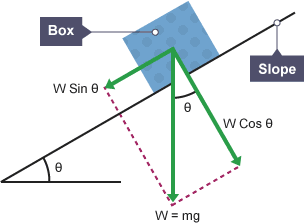What is mass?
Mass is a physical property of an object and it depends on the amount of matter that it contains.
What is weight?
Weight is a force ,acting vertically downwards on an object, that depends on the mass of the object and the acceleration due to gravity. It is defined as the gravitational force acting on an object through its centre of mass.
What is the centre of mass?
The centre of mass is a point through which an externally applied force produces straight line motion but no rotation.
What are the 6 important forces you need to know about?
Weight force
friction force
Drag force
Tension force
Upthrust
Normal contact force
What is friction force?
Friction force is the force that arises when two surfaces rub against each other.
What is Drag force?
Drag force is the resistive force on an object travelling through a fluid (e.g water, air…)
What is tension force?
Tension force is the force within a stretched cable or rope.
What is upthrust?
Upthrust is the upward buoyancy force acting on an object when it is in a fluid.
What is normal contact force?
Normal contact force is the force that arises when one object rests against another object.
what are the two components of the weight force for an object on a slope?
Weight force parallel to the slope: weight x sinθ
weight force perpendicular to the slope: weight x cosθ

Which weight component is responsible for the acceleration of an object down a slope?
The weight force parallel to the slope (w x sinθ)
What is the weight force perpendicular to the slope the same as?
This component of the weight force is the same magnitude as the normal contact force between the object and the slope.
This is because there is no acceleration in the perpendicular direction to the slope for the object, meaning that the net force in the perpendicular direction must equal zero. The normal contact force acts in the opposite direction to the perpendicular weight component.
What factors affect the magnitude of drag?
The speed of the object
The shape of the object
The roughness/ texture of the object
The density of the fluid that the object travels through.
(The two most important factors are the speed and the cross-sectional area of the object).
What happens to the drag force when the cross-sectional area increases?
when the cross-sectional area is increased, the drag force acting on that object increases.
What is drag force directly proportional to?
Drag is directly proportional to (velocity)2
(When speed is doubled, the drag force increases by a factor of 4).
What is the equation for the acceleration of an object during free fall?
a = (mg (weight) - D (Drag) ) / m (mass) (net force/mass)
What is the moment of a force?
The moment of a force is the turning effect of a force about an axis or point.
What is the equation for a moment?
moment = Force x perpendicular distance from the line of action of the force to the point of rotation.
moment = Fx
What is the unit for moments?
The unit for moments is Nm (newton meters).
What is the definition of the principle of moments?
For a body in rotational equilibrium, the sum of the anticlockwise moments about any point is equal to the sum of the clockwise moments about the same point.
What is a couple?
A couple is a pair of equal but opposite, parallel forces that act on different positions on an object, causing rotational motion without any translational motion.
What is the torque of a couple?
The torque of a couple is the moment of the couple.
What is the equation for a torque?
torque = Fd (torque = one of the forces x perpendicular distance between the two forces)
What is density?
The density of a substance is defined as the mass per unit volume of the substance.
Its unit is Kgm-3
What is the equation for density?
density = mass/volume (ρ = m/V)
What is pressure?
Pressure is the force exerted on something per unit cross-sectional area.
Its units are Pa (pascals) or Nm-2
What is the equation for pressure?
pressure = force/cross-sectional area (p = F/A)
What is the equation for the pressure exerted by a vertical column of any fluid?
pressure = height x density x acceleration due to gravity
p = hρg
What does the equation show?
It shows that pressure does not depend on cross-sectional area for a column of fluid, but instead depends on the depth of the column.
pressure is directly proportional to the depth of the column.
What is the equation for the upthrust acting on an object submerged in a liquid?
upthrust = height of object x cross-sectional area x density of liquid x acceleration due to gravity
upthrust = xAρg
What is the definition of Archimedes principle?
The upthrust exerted on a body immersed in a fluid, whether fully or partially, is equal to the weight of the fluid that the body displaces.